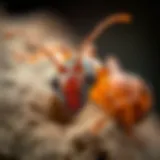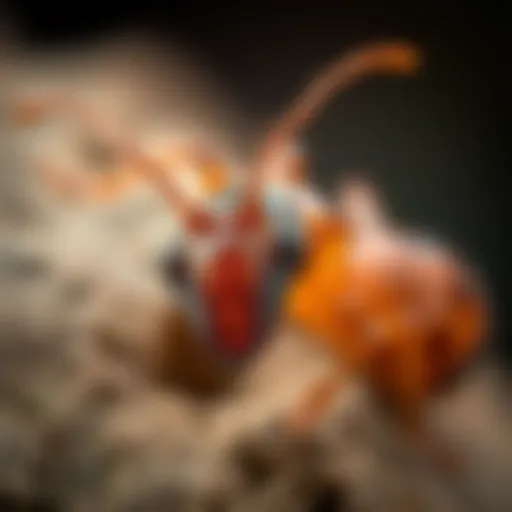Comprehensive Insights into PMI Pest Control Techniques


Intro
Pests can turn a peaceful home environment into a nightmare. Understanding how to manage these unwelcome guests is essential for homeowners. Ensuring that your living space is free of pests isn't just about comfort; it has implications for health and property value. This comprehensive guide will walk you through critical insights into PMI pest control, providing a roadmap to identify, prevent, and treat common pests effectively.
Pest Identification
Knowing your enemy is half the battle when it comes to pest control. Here, we delve into the commonly encountered pests that might invade your home, their traits, and how to spot the signs of infestation.
Detailed Descriptions of Common Pests
Several pests love to call homes their dwelling place. Among the most troublesome are:
- Termites - Often referred to as the silent destroyers, termites can eat through wood structures, causing extensive damage. They are particularly attracted to damp and decaying wood.
- Rodents - Mice and rats can infest homes, bringing diseases and troubling messes. Mice have small, pointed noses and are light brown or grey, while rats are larger with blunt noses.
- Cockroaches - These resilient critters thrive in warm and humid conditions. A telltale sign is their droppings, which look like small black specks.
- Ants - Often seen scouting for food, these little workers communicate pheromone trails to guide others to a food source.
Signs and Symptoms of Infestations
Identifying a pest issue promptly is vital for effective intervention. Here are some signs to watch for:
- Droppings - Finding small droppings around food particles or hidden corners is a surefire sign of a pest problem.
- Nesting Materials - Chewed paper, fabric, or plant materials can indicate nesting behavior by rodents or insects.
- Unusual Noises - Scratching or scuttling sounds, particularly at night, suggest that you may have unwanted guests.
- Visual Sightings - Simple, but critical. Occasionally spotting these pests will often confirm your worries.
"Early detection of these pests can save you time, money, and a whole lot of headaches."
Prevention Strategies
Now that we have an understanding of what pests might invade our homes, let's move on to strategies to keep them at bay. Prevention should always be the first line of defense.
Home Maintenance Tips for Pest Prevention
Making your home less inviting to pests is crucial. Here are some straightforward maintenance tips:
- Seal Entry Points - Inspect windows, doors, and any cracks in the foundation. Use caulk to seal gaps, preventing pests from slipping inside.
- Keep a Clean Kitchen - Wipe down surfaces regularly and store food in airtight containers. This practice makes it difficult for pests to find a meal.
- Manage Moisture - Fix leaky pipes and ensure proper drainage around your property. Pests like termites and cockroaches are attracted to damp areas.
- Regular Trash Disposal - Dispose of garbage frequently. Pests are opportunistic and drawn to food waste.
Natural Deterrents and Barriers
Finding less toxic ways to deter pests can be effective without endangering your family or pets. Some natural deterrents include:
- Essential Oils - Oils such as peppermint, tea tree, and lemon can repel various insects. Dilute and spray in areas where you've noticed pest activity.
- Diatomaceous Earth - This powdery substance can be sprinkled in areas where pests are likely to travel. It dehydrates insects on contact.
- Cedar Mulch - For those with gardens, cedar mulch can help repel insects naturally and add aesthetic value.
Treatment Options
When prevention fails, it’s time to consider treatment options to get rid of those pesky intruders effectively.
Overview of Chemical vs. Natural Treatments
When the need arises for treatment, both chemical and natural options are available:
- Chemical Treatments - These are more potent and can yield faster results. However, they come with risks of toxicity if not used correctly.
- Natural Treatments - Generally safer for families and pets. While they may take longer to see results, they can provide a sustainable solution.
Step-by-Step Guides for DIY Treatments
If you feel up to the task, here’s how to approach some common DIY pest treatments:
- For Ants: Mix equal parts of vinegar and water in a spray bottle, then spray nests and common trails.
- For Cockroaches: Create a bait using boric acid and sugar. Sprinkle it in areas where cockroaches frequent.
- For Termites: Applying nematodes, microscopic worms, to infested wood can help eliminate termites effectively.
Understanding PMI Pest Control
Pest control is no small potatoes in today’s world. With homes becoming increasingly susceptible to various pests, understanding PMI pest control is crucial for maintaining a safe and healthy living environment. This section aims to shed light on the facets that make PMI pest control essential. Homeowners, including busy housewives and families, stand to gain considerably by grasping these fundamentals. When one understands the principles behind effective pest management, not only can they keep their homes secure, but they also save on costs associated with damages and health risks.
There’s a treasure trove of knowledge hidden beneath the surface of pest control practices, which often goes overlooked. PMI focuses on a set of principles tailored to make pest management both proactive and effective. These include identifying harmful pests, understanding their behavior, and implementing strategic actions that maintain control over pest populations.
Definition and Scope
PMI, or pest management initiatives, encompass an array of practices designed to prevent, monitor, and control pest populations. Simply put, it’s not just about exterminating; it’s about ensuring that pests don’t become a reoccurring headache.
With pest control, the scope extends far beyond just treating an infestation. It involves a holistic approach that covers everything from structural modifications and environmental adjustments to behavioral changes in residents. Homeowners should view it as a multi-step strategy rather than just a one-off solution. For instance, regular inspections and timely treatments can nip potential problems in the bud.
Key aspects of PMI include:
- Preventative Procedures: Understanding how to keep pests at bay means learning about structural vulnerabilities that add to the dilemma.
- Monitoring Procedures: Regular checks ensure that any early signs of infestation are caught before they escalate, like a weed in a garden.
- Control Measures: Having a plan that combines both chemical and natural remedies can keep pest populations manageable.
Importance in Modern Pest Management
In the age of information, many homeowners are eager to take the reins on pest management. The modern approach to pest control, especially through PMI, aligns well with these changing dynamics. Here’s why it matters:
- Health Benefits: Some pests can transmit diseases, while others may cause allergies or asthma. By keeping a close eye on potential invasions, families can stay healthier and happier.
- Financial Awareness: An ounce of prevention is worth a pound of cure. Identifying pests before they become full-blown infestations can save homeowners from costly repairs.
- Environmental Considerations: As awareness surrounding environmental issues grows, PMI lean towards more sustainable practices, such as opting for eco-friendly solutions whenever feasible. Moreover, those strategies can help avoid harmful pesticide exposure for both humans and pets.
"Knowledge is power, especially when it comes to protecting your home from uninvited guests."
By grasping these concepts, homeowners can navigate the pest control waters with more confidence, armed with strategies that make sense and skirts unnecessary hassle.
The Foundation of Pest Management Principles
A solid grasp of pest management principles is crucial for anyone involved in maintaining a pest-free environment. When homeowners or pest control professionals understand these foundations, they are much better equipped to tackle pest-related challenges effectively. This section delves into the three pivotal components of pest management: prevention, monitoring, and control strategies. Each of these elements plays a significant role in ensuring the long-term efficacy of any pest management plan.
Prevention
Identifying Risk Factors
Identifying risk factors is about knowing what attracts pests to your home and understanding the local environment. It's like checking the weather before planning a picnic. One might not think about small cracks or excess moisture as an invitation to pests, but they certainly can be. Homeowners should keep an eye out for potential causes of infestations, such as:
- Standing water: Puddle here, a leaky faucet there, all equal a watering hole for pests.
- Food sources: Leftover pet food or an untouched crumb could lure unwelcome guests.
- Seasonal changes: Understanding when pests are most active can help mitigate risks.
What makes identifying risk factors particularly effective is that it empowers homeowners to take preventive measures before an infestation occurs. By recognizing what may attract pests, they can proactively mitigate these risks. This not only saves money in the long run but also preserves the peace in one's living space.
Sealing Entry Points
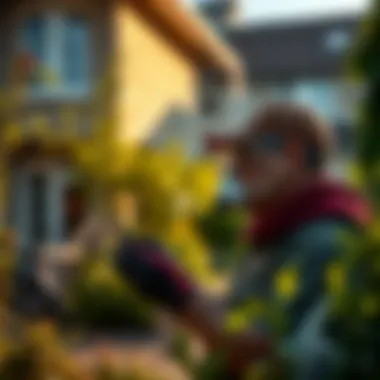

Sealing entry points is another critical component of pest prevention. Cracks in the foundation, gaps around windows, and improperly sealed doors can serve as free passes for pests. Homeowners should conduct assessments around their residences, looking for areas where pests could sneak in.
- A key feature of this technique is that it involves a one-time investment for ongoing protection.
- When effectively sealed, homes can significantly reduce pest entries, making this a smart tactic.
- However, it's important to note that sealing entry points may require some DIY skills or professional help, depending on the scope of the gaps and cracks.
Monitoring
Regular Inspections
Regular inspections are indispensable in pest management. Think of it this way: conducting frequent checks on your house is like keeping up with your car's oil changes; it's all about preventing bigger issues down the line. With regular inspections, you can catch minor signs of infestation before they spiral into a full-blown problem. Checking for droppings, nests, or signs of chewing can help homeowners stay ahead of potential pest invasions.
- Also, this proactive check helps you understand your property's unique pest landscape, establishing a baseline for any changes that might occur.
- While it may require some investment of time, the long-term benefits can be significant—it’s much cheaper to act early on than to wait for an issue to escalate.
Pest Activity Tracking
Tracking pest activity has become increasingly vital in a world traipsing toward more data-driven solutions. By keeping logs of sightings and behavioral changes, homeowners can better understand when and where pests seem to congregate. This method allows homeowners to fine-tune their pest management strategies based on real observations, which can lead to better results.
- Some manufacturers even offer technology and devices that help in monitoring pest activity live.
- However, keep in mind that tracking can be labor-intensive but provides remarkable insight that can guide future actions.
Control Strategies
Chemical Treatments
Chemical treatments are often the go-to option for more significant infestations. They boast a variety of choices ranging from sprays to granules, targeting different species effectively. While the idea of chemicals may sound daunting, many formulations are now designed for safety and efficiency, making them user-friendly.
- Key to their effectiveness is understanding when and how to apply them properly. Misuse can lead to ineffectiveness and even harm the environment.
- An undeniable disadvantage, however, lies in the potential environmental consequences, which is an increasing concern among homeowners.
Natural Remedies
Natural remedies have gained traction among those looking for eco-friendly options. Using ingredients like diatomaceous earth or essential oils, this method appeals to many homeowners who favor green strategies. What's set natural remedies apart is their dual advantage: they can often deter pests without posing risks to humans or pets.
- While some remedies show promise for light infestations, homeowners should be aware that natural options might not deliver the same immediate results as chemical solutions in severe cases.
Integrated Approaches
Integrated approaches of pest management—combining prevention, monitoring, and control strategies—are becoming more favorable in today’s pest management landscape. This holistic view takes into account the balance of natural ecosystems while effectively managing pests.
- The primary benefit here is sustainability; it emphasizes long-term solutions rather than short-lived fixes.
- However, developing an integrated approach can require additional knowledge and may be seen as a lengthy process, which can deter some homeowners.
By laying this essential groundwork in pest management, homeowners will be more adept at creating strategies after understanding the principles discussed. Each principle interlocks, forming a comprehensive approach to pest management that is sure to keep living spaces comfortable and pest-free.
Identifying Pests Effectively
Identifying pests accurately is crucial for effective pest control. Not only does it influence the choice of treatment methods, but it also helps in assessing the extent of the problem. Confusing similar species can lead to ineffective treatments, unnecessary expenses, and in some cases, exacerbating the infestation. Homeowners should be equipped with the knowledge to spot common pests, understand their behaviors, and recognize signs that suggest an infestation.
Common Household Pests
Termites
Termites are often called the silent destroyers, capable of causing significant damage before a homeowner even realizes they’ve moved in. These pests flourish in wood-rich environments, making them a particularly relevant concern for house owners. One key characteristic of termites is their social structure; they live in colonies that can range from a few thousand to millions. This colony lifestyle enables them to work collectively, leading to substantial, often unnoticed, damage over time. Their ability to digest cellulose found in wood allows them to thrive undetected, which is both a benefit to their survival and a disadvantage to homeowners who may not detect them until it's too late.
Ants
Ants are another common pest that many may find in their homes. They exhibit fascinating social behavior, forming organized colonies and working cooperatively to find food. The key characteristic of ants is their ability to communicate and collaborate, which makes eradicating them a challenge. For homeowners, ants can signal an issue with food storage or cleanliness, as they generally invade spaces where they can find edible materials. However, they can also help pollinate plants and decompose organic matter, offering some ecological benefits despite their annoying presence indoors.
Cockroaches
Cockroaches are perhaps one of the most reviled household pests. Known for their resilience and adaptability, cockroaches can survive in extreme conditions. One striking feature of cockroaches is their fast reproduction rate; a single female can produce hundreds of offspring in a year if left unchecked. This creates a challenge for homeowners, as an infestation can escalate rapidly. Moreover, cockroaches are linked with health hazards, as they can carry diseases and trigger allergies. So while they can adapt to various environments, their presence in your home is anything but beneficial.
Signs of Infestation
Visual Indicators
Visual indicators are the most direct way to ascertain if pests are present in your home. Common signs include physical droppings, gnaw marks, and even damaged wood—especially for termites. Spotting these indicators early can save you from more significant problems down the line. The key to any effective pest management strategy is vigilance. Homeowners should regularly inspect for these signs; a tiny clue can often lead to understanding a much larger infestation.
Behavioral Changes
Behavioral changes in occupants can also be telling. For instance, pets may start to exhibit unusual behavior, like scratching at walls or being overly curious in specific areas, indicating hidden pests. Moreover, if family members start to show allergic reactions, it might relate to a pest presence. While these changes can sometimes be overlooked, they're crucial signals of an impending or existing pest problem. Understanding and monitoring these behaviors can aid homeowners tremendously in creating a pest-free environment.
Prevention Techniques for Homeowners
When it comes to pest control, prevention is always better than cure. Homeowners can take several steps to keep their living spaces pest-free, ultimately saving time, money, and the hassle of dealing with infestations. By focusing on specific techniques, they can effectively minimize risk factors and create an environment that is less appealing to pests. Here, we explore essential prevention methods that every homeowner should consider.
Structural Modifications
Landscaping Practices
Landscaping plays a pivotal role in pest prevention. By choosing the right plants and maintaining them properly, you can discourage pests from making your garden their home. For instance, dense vegetation can attract unwanted critters, while well-spaced, open areas allow for better airflow and light, creating an environment that's less hospitable to pests. A key characteristic of good landscaping practice is selecting plants that are native to your region, as these are often more resilient to local pests.
However, a unique feature of landscaping is the ability to add barriers such as gravel or mulch around your house. These materials can prevent pests like ants and termites from entering your home. While this method is generally effective, it’s crucial to maintain these barriers regularly, as neglect might allow pests to slip through unnoticed.
Moisture Control
Moisture control is perhaps one of the most critical aspects of pest prevention. Many pests thrive in damp environments, making it essential for homeowners to address moisture around their properties. A key characteristic of moisture control is ensuring that any leaks or standing water are promptly addressed. For example, fixing leaky faucets and ensuring proper drainage can significantly reduce the likelihood of pests like cockroaches and termites.
This method also involves using dehumidifiers and ensuring proper ventilation in basements and attics. A unique feature of effective moisture control is that it not only fights pests but also improves air quality and prevents mold growth, offering a double advantage. The primary disadvantage, however, can be the maintenance required, as homeowners need to stay vigilant in checking areas prone to moisture.
Routine Maintenance
Regular Cleaning
Regular cleaning is indispensable for a pest-free home. By frequently cleaning all areas - including less visible spots like behind appliances and under furniture - homeowners can eliminate food residues and habitats where pests might linger. A key characteristic of a thorough cleaning routine is to incorporate high-touch areas and oft-neglected spaces into the schedule.
A unique feature of this approach is the use of different cleaning products targeting specific pests. For example, vinegar can deter ants, while baking soda may help with cockroach infestations. Although thorough cleaning is generally low-cost and accessible, homeowners must commit to consistency, as one lapse in cleaning can invite pests back into their homes.
Seasonal Inspections
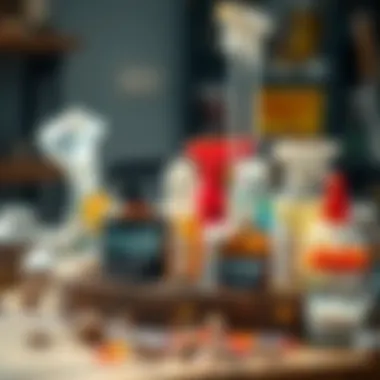

Seasonal inspections can be a game-changer in maintaining pest control. By assessing their properties at the change of each season, homeowners can catch early signs of infestations or conducive conditions before they escalate. A key characteristic of effective inspections involves checking areas like foundations, eaves, and basements for signs of pest activity or entry points.
Additionally, a unique feature of seasonal inspections is the ability to adapt strategies based on the seasons. For instance, in warmer months, the focus may shift to assessing outdoor areas, while in winter, it may be vital to check for leaks and warmth retention. The downside here might be the time investment required for comprehensive inspections, but the rewards of prevention far outweigh this effort.
In essence, a proactive approach to preventing pests through structural modifications and routine maintenance can significantly contribute to the overall well-being of your home. By implementing these techniques, homeowners not only safeguard their spaces but also enjoy a healthier living environment.
Effective Pest Control Treatments
In the realm of pest management, effective treatments serve a pivotal role. Understanding the types of treatments available can substantially influence a homeowner's approach to managing pest issues. It is key to grasp the balance of efficiency, safety, and environmental impact that these treatments entail. Whether one prefers chemical solutions or natural remedies, the choice of treatment can make a world of difference in the effectiveness of pest control.
Chemical Solutions
Types of Pesticides
When discussing chemical treatments, one cannot overlook the various types of pesticides. Each category plays a particular role in pest management. There are insecticides, herbicides, fungicides, and rodenticides, just to name a few. Among these, insecticides often capture the most attention because they target common household pests like cockroaches and ants. A noteworthy characteristic of insecticides is their specific targeting, which often leads to effective elimination of unwanted pests. However, there’s always the need to be cautious. Some pesticides might affect beneficial insects along with the pests.
Moreover, the selection of a pesticide comes down to its formulation. For example, some are designed for immediate knockdown, while others offer residual effects, continuing to work long after application. This unique feature can be advantageous in controlling ongoing infestations, but reliance on such products needs to be measured against potential health risks and environmental considerations.
Application Techniques
The way a pesticide is applied can make or break its effectiveness. Various application techniques exist, including spraying, granulating, or baiting. Each method caters to different situations. Spraying, for example, allows for broad coverage, making it a popular choice for outdoor pest control where many pests reside. However, this approach can lead to overspray and wastage if not managed properly.
On the flip side, baiting offers a more targeted approach. It draws pests into a small area, effectively minimizing the exposure of non-target organisms to chemicals. This method serves as a sustainable choice but demands careful placement to ensure efficacy. In summary, understanding the nuances of application techniques may influence a homeowner’s decision in choosing the right pest control strategy.
Natural Remedies
Essential Oils
Natural remedies are gaining traction for their ability to offer pest control without harsh chemicals. Essential oils have emerged as a favorite in many households. They are not only versatile but also possess inherent properties that can repel or incapacitate pests. For instance, peppermint oil is known for its effectiveness against spiders and ants. A significant aspect of essential oils is their aromatic presence, which leaves homes smelling fresh while warding off unwanted visitors.
The appeal of essential oils lies in their perceived safety; they often lack the harsh chemicals found in traditional pesticides. However, it’s essential to recognize that while they are generally safer, they may not always be as effective for severe infestations. Thus, understanding their application is crucial for optimizing their benefits in pest management.
Homemade Solutions
For those seeking a more hands-on approach, homemade solutions can prove effective and economical. These often utilize readily available materials around the home, such as vinegar, baking soda, and dish soap. The beauty of homemade solutions is twofold: they can be tailored specifically to the type of pest being targeted and they are generally safer for the environment.
However, these solutions come with their own set of challenges. Their effectiveness may vary significantly depending upon the pest and the severity of the problem. Therefore, while they can be a great preventive measure, relying solely on homemade solutions for an active infestation might not yield the desired results. Thus, a hybrid approach integrating both store-bought and homemade solutions can frequently yield the best outcomes.
In the world of pest control, the success often hinges not only on the treatments chosen but also on the methods of application and contextual understanding.
Integrated Pest Management Strategies
Integrated Pest Management (IPM) strategies are essential in the evolving landscape of pest control. The approach is not just a method to eradicate pests; it's about striking a balance between effective pest control and environmental stewardship. This section discusses how IPM weaves various practices together, creating a more robust and adaptable pest management framework.
Defining Integration
When we talk about integration in pest management, we're essentially referring to harmonizing different tactics to achieve a common goal: minimizing pest populations while reducing potential harm to non-target organisms and ecosystems. This means that homeowners and pest control professionals should not rely solely on a single approach, like chemical treatments. Instead, they should view pest management as a multi-faceted issue.
Think of it this way: just like one wouldn’t use just a hammer when fixing a house because there are various tools suited for different jobs, pest management benefits from a toolbox of strategies. This can include biological controls, like introducing natural predators, cultural practices, such as crop rotation, and mechanical methods, including traps. All of these components enhance the overall effectiveness of pest control efforts.
Benefits of Integrated Approaches
The benefits of employing integrated approaches in pest management are substantial. Not only does it lead to more effective pest control, but it also aligns with sustainability goals. Here are some significant advantages to consider:
- Reduced Chemical Usage: By incorporating biological and cultural controls, the reliance on chemical pesticides can significantly decrease. This reduction minimizes the potential risks to human health and the environment.
- Cost-Effectiveness: Although the upfront cost of implementing multiple strategies may seem high, the long-term savings are often considerable. Fewer chemical applications can lead to lower overall spendings on pest control.
- Enhanced Resistance Management: Using a variety of control methods can help curb the development of resistance in pests. By not allowing pests to become accustomed to a specific treatment, integrated strategies keep pest populations under control more effectively.
- Biodiversity Promotion: Integrated approaches often involve protecting beneficial organisms that contribute to a balanced ecosystem, promoting biodiversity in both landscapes and agricultural settings.
"An ounce of prevention is worth a pound of cure." This adage aptly applies to pest management. By embracing integrated strategies, homeowners can prevent infestations before they start, ultimately leading to healthier living environments.
Myths and Misconceptions in Pest Control
Understanding the myths and misconceptions in pest control is not just a walk in the park; it is crucial for preparing homeowners to effectively manage their pest issues. The realm of pest management can be clouded with misinformation, leading many to embrace ineffective solutions or, worse, exacerbate their problems. By addressing common misconceptions, this article seeks to empower readers with knowledge that not only improves their pest control practices but also saves time and money.
Debunking Common Myths
- “All pesticides are dangerous.”
While certain pesticides can indeed be hazardous, it's important to distinguish between types. Many modern pest control solutions are formulated with safety in mind, utilizing biopesticides that target specific pests without harming humans or pets. Reading labels and understanding the ingredients can help homeowners choose safely. - “You only need to treat once.”
A common belief is that a single treatment can eliminate pests for good. Unfortunately, it’s often more complicated. Pests can have life cycles and behaviors that require ongoing monitoring and treatment. For example, termites may require multiple treatments over time to ensure they are effectively controlled and eliminated. - “Natural solutions are ineffective.”
This myth stems from how natural remedies are often disregarded as weak alternatives. However, many natural substances, like diatomaceous earth and essential oils, have been proven to effectively deter pests or disrupt their life cycles when applied correctly. - “If you see one pest, there’s not many more.”
Seeing just one ant or cockroach can lead you to believe it’s an isolated incident. Unfortunately, many pests are social and can live in colonies or groups. What you see is frequently just the tip of the iceberg. Keeping a vigilant eye on pest patterns is essential, particularly for social species like ants or bees. - “DIY methods are always sufficient.”
While DIY approaches can sometimes provide temporary relief, they often miss underlying issues contributing to infestations. Professional pest control services bring in expertise and tools that are not readily available to the average homeowner, finding hidden access points and addressing deeper problems.
Understanding Realities
The reality of pest control is layered with complexity. Here’s what every homeowner should understand:
- Prevention is key.
Regularly inspect your property and seal up cracks or holes, as preventative measures are far more effective than dealing with full-blown infestations. - Know the enemy.
Educating yourself about potential pests in your area—what they look like, their habits, and the damage they can do—equips you to act quickly when issues arise. Resources like the National Pesticide Information Retrieval System can be invaluable. - Integrative approach.
Employing a combination of techniques often yields the best results. Whether it’s chemical, natural, or physical deterrents, utilizing all available methods tailored to specific pests can lead to successful management strategies. Integrated Pest Management (IPM) tailors treatments to the pest and the environment, reducing unnecessary pesticide use while enhancing efficacy.
"The key to successful pest control lies in knowledge and understanding, which naturally leads to more effective actions."
By clearing up these myths and understanding the realities of pest control, homeowners can take informed actions that lead to healthier, pest-free living spaces. Each step taken towards understanding pest control can serve as a layer of defense in your home, allowing for peace of mind and comfort.
Challenges in Pest Control Management
Pest control is not a walk in the park; it's a field filled with hurdles that many homeowners face. Understanding these challenges is vital not just for pest control professionals but also for house owners eager to tackle infestations before they spiral out of control. Addressing challenges effectively can lead to better prevention strategies and ultimately, a pest-free living environment.
Resistance to Treatments
One of the primary headaches in pest management is resistance to treatments. Over time, certain pests adapt and develop resilience against commonly used pesticides. This resistance can make previous control methods obsolete, causing much frustration for both homeowners and professionals trying to maintain a pest-free home.
- Why does resistance happen? Pests reproduce quickly, and when they are exposed to treatment, the ones that survive can pass on their resistant traits to the next generation. For example, if a homeowner frequently uses the same type of insecticide, there's a good chance that over time, the pest population will mutate, rendering that treatment less effective.
- What can be done? Here are a few actions to consider:
- Rotate treatments: Change the type of pesticides used regularly to avoid creating a resistant population.
- Integrate different methods: Use mechanical traps, natural remedies, and pesticides in conjunction to avoid reliance on one method.
- Educate yourself: Staying informed on the latest pest control strategies can aid in applying the most current methods.
"Resistance is like a thick wall. To get through it, you need more than just a hammer; you need a thoughtful plan."
Evolving Pest Behaviors
In addition to resistance, there are evolving pest behaviors that can make effective pest control feel like trying to nail jelly to a wall. As human environments change, so do the habits and habitats of pests.
- Adaptability: Pests often change their nesting or feeding habits based on environmental cues. For instance, cockroaches might become more active during nighttime in response to human activity, reducing the likelihood of being seen during the day.
- Learned behaviors: Some pests learn to avoid traps or bait over time. For example, rats might grow wary of specific types of traps if they’ve previously encountered them without consequence.
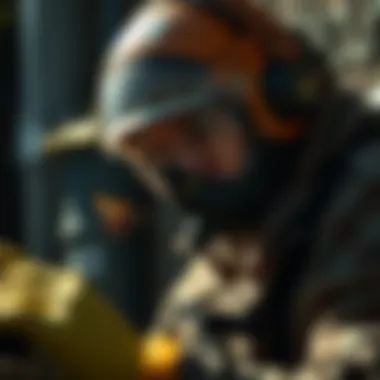

Addressing These Challenges
To tackle these challenges, homeowners can take a proactive approach:
- Stay observant: Regularly monitor for any signs of pest activity. The sooner a problem is detected, the easier it can be to manage.
- Implement preventive measures: Simple actions, like sealing entry points and reducing clutter, can create barriers that discourage pests from entering.
- Seek professional help: Sometimes, calling in experienced pest control professionals can be the most effective choice, especially for larger infestations.
Understanding the challenges of pest control management opens the door to more effective strategies and solutions. By adapting to these hurdles, house owners can not only improve their home environment but also engage in ongoing pest management that benefits their living space for years to come.
The Role of Technology in Pest Control
In the evolving domain of pest management, technology has emerged as a pivotal player, reshaping not only how pests are identified and controlled but also how the processes are administered. This integration of advanced tools and methodologies significantly enhances effectiveness and efficiency, providing benefits that are not only cost-effective but also environmentally considerate. As pest management professionals and homeowners seek assurances in their pest control tactics, leveraging technology becomes not just advantageous but necessary.
Advancements in Monitoring
When it comes to the core of pest control, meticulous monitoring underpins success. Technological advancements have introduced innovative tools that enable real-time assessments. Smart sensors and traps are increasingly utilized to detect pest activities before they evolve into serious infestations. For example, devices like pest cameras equipped with motion detectors help homeowners stay a step ahead, providing visual confirmation for potential issues.
Furthermore, applications that analyze weather patterns can hint at optimal pest activity, guiding intervention strategies in a more timely manner.
- Remote Monitoring Systems: Homeowners can now install systems that alert them via their smartphones about unusual movements related to pests. This shift towards smart technology makes pest management less reactive and more proactive.
- Data Analytics Tools: These tools can interpret collected pest activity data, offering insights into trends. By understanding peak activity times, you can better schedule inspections or treatments.
It’s about marrying tech and experience, creating an intelligent system that responds with precision. The amalgamation of automation and human insight is like hitting two birds with one stone, allowing for precise actions that can reduce the environmental footprint.
Data-Driven Decisions
The importance of data cannot be overstated in pest control. Data-driven decision making transforms the way pest issues are approached. It goes beyond just anecdotal evidence from previous problems, utilizing a wealth of information collected over time to cultivate more effective strategies.
Pest control companies are beginning to adopt big data into their operational engines. By tracking pest populations, treatment effectiveness, and client feedback, they can tailor solutions specifically to the needs of each unique situation.
Here’s how it works:
- Identifying Patterns: Through data analysis, pest control professionals can notice patterns that might not be immediately visible—like seasonal infestations calibrated with climate changes.
- Cost Effectiveness: By understanding which methods yield the best results for specific pests, professionals can allocate resources judiciously, leading to more savings and better service for homeowners.
- Customized Strategies: Every home is different, and so are its pest-related challenges. By leveraging data insights, pest control strategies can be customized. For example, if data shows ants are particularly attracted to bread crumbs in a certain neighborhood, targeted advice to homeowners can be provided.
The endgame here is to create an ecosystem where decision making is informed, minimizing both pest risks and treatment costs. As technology continues to advance, the potential for improved pest management practices only grows, illuminating the path toward future developments in pest control.
"Adopting technology in pest control is not just about keeping pests at bay; it's about shaping a more sustainable future."
In summary, the role of technology in pest control signifies a monumental shift, marrying traditional pest management approaches with modern innovations. Homeowners can achieve noticeable peace of mind by embracing these tools, ensuring that their environments remain devoid of unwanted pests. By engaging with these advancements today, they not only protect their homes but also cultivate a healthier relationship with their surroundings.
Regulatory and Environmental Considerations
The regulatory landscape surrounding pest management is vast and complex. Understanding these regulations is crucial for homeowners and pest control professionals alike. They not only dictate what methods and materials can be used for pest control but also aim to protect human health, wildlife, and the environment. When addressing pest control strategies, considering the legal implications is not just about compliance, it’s also about responsibility and stewardship towards the environment.
Legislation in Pest Management
Pest management legislation varies from one region to another, but some universal principles can be identified. Most regulations seek to ensure the safety of pest control treatments for humans, animals, and the ecosystem. For instance, in the United States, the Environmental Protection Agency (EPA) plays a pivotal role. They evaluate pesticides before they can be registered for use. Homeowners and professionals should familiarize themselves with regulations such as the Federal Insecticide, Fungicide, and Rodenticide Act (FIFRA), which outlines how pesticides should be used, labeled, and sold.
Homeowners looking to apply pest control treatments personally must follow local laws. Regulations may require proper labeling of chemicals used in the home, ensuring that all applications are not just effective but also safe. Furthermore, some jurisdictions enforce restrictions on certain pesticides, encouraging the use of Integrated Pest Management (IPM) practices that emphasize preventive methods and ecological approaches to pest control.
"Knowledge of legislation is like an ace up your sleeve. When you know the laws, you can safely and effectively manage pests while protecting your space and our planet."
Environmental Impact of Pesticides
Pesticides play a significant role in pest control, but their impact on the environment deserves careful consideration. When pesticides are used indiscriminately, they can endanger the balance of local ecosystems. Runoff from treated areas can contaminate nearby water sources, harming aquatic life and even tainting drinking water supplies. Additionally, the decline in pollinators, like bees, has been partly attributed to pesticide misuse.
Homeowners are encouraged to explore less harmful treatment options. This shifts the focus to environmentally friendly products, such as those derived from natural sources. Also, practices like spot treatments rather than blanket applications can greatly reduce the environmental load.
Moreover, understanding the life cycle of pests helps inform better timing for treatments, reducing the need for repeated applications and their associated environmental risks.
- Consider these practices to mitigate pesticide use:
- Use targeted, species-specific treatments whenever possible.
- Opt for biodegradable or low-toxicity alternatives.
- Implement preventive strategies to reduce reliance on chemicals.
In summary, regulatory and environmental factors are fundamental to effective pest management. They not only protect human health but also support the fragility of our ecosystems. By adhering to guidelines and considering the bigger picture, homeowners can engage more responsibly in pest control practices.
Future of Pest Control
The future of pest control is not just a passing notion; it’s vital in shaping effective methods and strategies for tackling pests in our homes and communities. With the world shifting toward sustainability and technological advancements, pest management is following suit. Homeowners, particularly housewives and house owners, must stay ahead of these changes to ensure their living spaces remain safe and pest-free. Understanding future trends and sustainable practices will help them make informed decisions that align with not just their comfort but also the environment.
Emerging Trends
As we look ahead, various significant trends emerge in pest control. Here are a few worth noting:
- Smart Technology Integration: Modern pest control is increasingly relying on technology. Devices such as automated traps and sensors are being developed to detect pests before they become a bigger issue. These smart devices can alert homeowners via smartphone apps, providing real-time data on pest activity.
- Biological Pest Control: There’s a trend towards using natural predators to manage pest populations. For instance, introducing ladybugs in gardens can reduce aphid numbers. This method minimizes the need for chemical pesticides, making it a safer choice for household environments.
- Data Analytics for Pest Monitoring: The use of big data and analytics is transforming how professionals assess pest threats. By analyzing environmental data, pest control companies can better predict infestations and offer targeted solutions, which can save homeowners time and money.
- Customized Pest Management Plans: Today’s pest control services are tailoring their approaches based on specific homeowner needs. Rather than a one-size-fits-all model, companies are developing personalized strategies that consider the unique aspects of each property, leading to more effective results.
Sustainable Practices
In line with emerging trends, sustainable practices in pest control are gaining traction. Homeowners can engage in several effective and eco-friendly strategies:
- Integrated Pest Management (IPM): This approach emphasizes prevention through education, monitoring, and intervention. By focusing on the full life cycle of pests, IPM seeks to minimize risks to people and the environment while effectively managing pest populations.
- Organic Pesticides: Homeowners can opt for organic or natural pesticides that are less harmful than their chemical counterparts. These alternatives often include ingredients derived from plants that disrupt pests��’ life cycles without posing significant risks to humans or pets.
- Cultural Controls: This involves modifying how we maintain our homes and gardens to discourage pest establishment. For instance, ensuring proper drainage and reducing clutter can significantly lower pest attraction and breeding grounds.
“Embracing sustainable practices not only protects our homes but also ensures a healthier planet for future generations.”
- Education and Awareness: Knowledge is power. Homeowners should stay informed about pest behaviors and life cycles to implement effective prevention measures. Additionally, understanding the potential impact of various control methods can guide environmentally conscious decisions.
By embracing both emerging trends and sustainable practices in pest control, homeowners do not just react to pest situations as they arise. They can proactively manage their environments, balancing comfort with ecological responsibility. This forward-thinking approach equips them with tools and knowledge essential for maintaining healthy living spaces, ensuring they remain one step ahead of any pest-related challenges.
End
In the realm of pest control, drawing together the lessons and strategies outlined throughout this article underscores its crucial role in securing our living environments. Pest control is not merely an act of dealing with nuisances; it is about safeguarding health, property, and peace of mind. For homeowners, understanding nuances of PMI pest control presents a sturdy shield against the intrusion of unwelcome guests like termites and other pests. This knowledge compels action and promotes proactive measures that far outweigh the reactive approaches often seen.
Summary of Key Points
- Understanding PMI Pest Control: It involves principles that promote a blend of prevention, monitoring, and control strategies tailored to specific pest problems.
- Importance of Identification: Knowing common household pests and their signs of infestation is foundational to effective management.
- Prevention Techniques: Regular structural maintenance, moisture control, and environmentally friendly modifications can significantly reduce pest occurrences.
- Control Methods: Chemical and natural treatments, when applied correctly, can manage infestations effectively.
- Integrated Approaches: Merging methods ensures a more robust defense against evolving pest populations, minimizing the risk of treatment resistance.
- Technological Role: Advancements in monitoring and data analysis help refine pest management strategies, making them more effective and targeted.
- Future Considerations: Sustainable practices are becoming vital in pest control, ensuring long-term effectiveness while reducing environmental footprints.
Call to Action for Readers
In summary, the knowledge gained from this article positions you—be it a homeowner, a DIY enthusiast, or a pest management professional—to take charge against pest invasions. Here’s what you can do:
- Educate Yourself: Familiarize yourself with local pests. Use resources like Wikipedia or britannica.com for more information.
- Implement Prevention Steps: Start by assessing your home for risk factors. Sealing entry points and maintaining cleanliness are simple yet effective acts.
- Utilize Monitoring Tools: Count on both traditional methods and modern technology to keep tabs on any pest activity.
- Stay Informed: Join forums on platforms like Reddit or follow pest control discussions on Facebook to keep up with latest trends and innovations.
By linking knowledge with action, we can navigate pest challenges effectively, ensuring our homes remain sanctuaries of comfort and safety.
